מעודכן ל: 8.9.2025
contract n. … (14c) 1. An agreement between two or more parties creating obligations that are enforceable or otherwise recognizable at law <a binding contract>. 2. The writing that sets forth such an agreement <a contract is valid if valid under the law of the residence of the party wishing to enforce the contract>. 3. A promise or set of promises by a party to a transaction, enforceable or otherwise recognizable at law; the writing expressing that promise or set of 4. Broadly, any legal duty or set of duties not imposed by the law of tort; esp., a duty created by a decree or declaration of a court <an obligation of record, as a judgment, recognizance, or the like, is included within the term “contract”>. 5. The body of law dealing with agreements and exchange. 6. The terms of an agreement, or any particular term <there was no express contract about when the money was payable>. 7. Loosely, a sale or conveyance 8. Loosely, an enforceable agreement between two or more parties to do or not to do a thing or set of things; a compact <when they finally agreed, they had a contract>.
Contract, Black’s Law Dictionary, (19th ed. 2019).
Contracts
Agreement
Obligation
Promise
Bargain
Arthur L. Corbin, et al., Corbin on Contracts (MB), Lexis (database updated June. 2025).
Richard A. Lord, Williston on Contracts (4th ed.), Westlaw WILLSTN-CN (database updated July. 2022).
Howard O. Hunter, Modern Law of Contracts, Westlaw MODCON (database updated Mar. 2022).
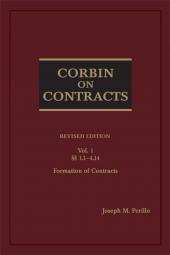 Corbin on Contracts
by
Corbin on Contracts is peerless as a contract law treatise, and is one of the most cited and influential treatises in print. The venerable 16-volume Corbin on Contracts has been hailed as "the greatest law book ever written". Corbin contracts law analysis is exhaustive, and addresses all of the rules of contract law, including exceptions and variations. No other contract treatise matches Corbin on Contracts to help you prevent disputes and keep your clients out of court. Cited in the opinions of federal and state courts literally thousands of times, this exhaustive exposition of all the working rules of contract law has helped lawyers understand what the rules of contract mean and how they can be used in daily practice for more than half a century.
Publication of the Revised Edition was directed by renowned contracts expert Professor Joseph M. Perillo. In addition to the periodic issuance of replacement volumes, the set is updated twice each year with cumulative stand-alone and pocket-part supplements prepared by noted legal scholar Dr. John E. Murray, Jr. (1932-2015), former Chancellor and Professor of Law, Duquesne University, and Timothy Murray, Partner, Murray, Hogue & Lannis, Pittsburgh, Pennsylvania.
eBooks, CDs, downloadable content, and software purchases are noncancelable, nonrefundable and nonreturnable. Click here for more information about LexisNexis eBooks. The eBook versions of this title may feature links to Lexis+® for further legal research options. A valid subscription to Lexis+® is required to access this content.
Corbin on Contracts
by
Corbin on Contracts is peerless as a contract law treatise, and is one of the most cited and influential treatises in print. The venerable 16-volume Corbin on Contracts has been hailed as "the greatest law book ever written". Corbin contracts law analysis is exhaustive, and addresses all of the rules of contract law, including exceptions and variations. No other contract treatise matches Corbin on Contracts to help you prevent disputes and keep your clients out of court. Cited in the opinions of federal and state courts literally thousands of times, this exhaustive exposition of all the working rules of contract law has helped lawyers understand what the rules of contract mean and how they can be used in daily practice for more than half a century.
Publication of the Revised Edition was directed by renowned contracts expert Professor Joseph M. Perillo. In addition to the periodic issuance of replacement volumes, the set is updated twice each year with cumulative stand-alone and pocket-part supplements prepared by noted legal scholar Dr. John E. Murray, Jr. (1932-2015), former Chancellor and Professor of Law, Duquesne University, and Timothy Murray, Partner, Murray, Hogue & Lannis, Pittsburgh, Pennsylvania.
eBooks, CDs, downloadable content, and software purchases are noncancelable, nonrefundable and nonreturnable. Click here for more information about LexisNexis eBooks. The eBook versions of this title may feature links to Lexis+® for further legal research options. A valid subscription to Lexis+® is required to access this content.
 Farnsworth on Contracts
by
Bring the expertise of America's foremost authority on contracts into your practice with this comprehensive three-volume set. Farnsworth on Contracts, Fourth Edition is where doctrine meets practice. Now in loose-leaf format, this ultimate guide to contracts is designed to increase readability and usefulness for practitioners while providing the most up-to-date content.
In the years since the prior edition, contracts law has developed in both anticipated and surprising ways. Arbitration agreements became even more common, and the Supreme Court upended a significant body of state caselaw regarding their enforceability. Online contracting became more common and more complex. Courts were joined by legislators and administrative agencies in setting new limits on contracts. Accordingly, the previous edition had been supplemented with authorities confirming the doctrines described in the prose, building nuances onto them, and questioning or completely departing from them. The new edition retains most of the earlier supplemental material and overall structure of the book, but reorganizes the content to present changes in the law more clearly and to collect all relevant material in areas that are seeing the most litigation. It also moves to a looseleaf format, so future developments can be incorporated seamlessly and accessed efficiently. Farnsworth illustrates how contemporary contract law has been shaped by both the Restatement (Second) of Contracts -- for which he served as Reporter -- and the Uniform Commercial Code. Easy access to specifics, new cases, new drafting tips, new references, and timesaving features like cross-referenced cases and marginal headings make this three-volume set a valuable resource for contracts research and practice, including litigation and arbitration. Farnsworth on Contracts, Fourth Edition is the most authoritative contracts treatise available.
Farnsworth on Contracts
by
Bring the expertise of America's foremost authority on contracts into your practice with this comprehensive three-volume set. Farnsworth on Contracts, Fourth Edition is where doctrine meets practice. Now in loose-leaf format, this ultimate guide to contracts is designed to increase readability and usefulness for practitioners while providing the most up-to-date content.
In the years since the prior edition, contracts law has developed in both anticipated and surprising ways. Arbitration agreements became even more common, and the Supreme Court upended a significant body of state caselaw regarding their enforceability. Online contracting became more common and more complex. Courts were joined by legislators and administrative agencies in setting new limits on contracts. Accordingly, the previous edition had been supplemented with authorities confirming the doctrines described in the prose, building nuances onto them, and questioning or completely departing from them. The new edition retains most of the earlier supplemental material and overall structure of the book, but reorganizes the content to present changes in the law more clearly and to collect all relevant material in areas that are seeing the most litigation. It also moves to a looseleaf format, so future developments can be incorporated seamlessly and accessed efficiently. Farnsworth illustrates how contemporary contract law has been shaped by both the Restatement (Second) of Contracts -- for which he served as Reporter -- and the Uniform Commercial Code. Easy access to specifics, new cases, new drafting tips, new references, and timesaving features like cross-referenced cases and marginal headings make this three-volume set a valuable resource for contracts research and practice, including litigation and arbitration. Farnsworth on Contracts, Fourth Edition is the most authoritative contracts treatise available.
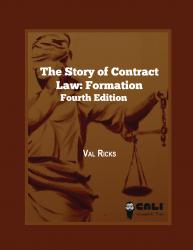 The Story of Contract Law: Formation
by
This book, revised as the Fourth Edition June 2021, is designed to teach contract doctrine beginning with the most fundamental concepts and building on these until the structure of contract doctrine as coherent and cohesive regulation appears. The order of presentation is, in fact, the order in which contract doctrine developed historically, but it is also, in general, the order in which arguments are introduced in litigation.
The book begins with the most basic, core concept of contract law—exchange. The book teaches exchange using simple cases drawn from the actual development of the exchange concept’s most obvious manifestation—the doctrine of consideration. These cases have basic but engaging facts. They do not take long to read, but they must be read carefully. They make an excellent introduction to law study.
Logically, every doctrine of contract formation is centered on whether and when a fair exchange occurred. In litigation, the plaintiff alleges a promise and consideration—an exchange (a plausible one, and therefore fair enough at that point). Defenses to formation are a response to the allegation that a fair exchange occurred. Allegations of both promise and consideration show that the defendant assented. As between assent and exchange, exchange is the more fundamental concept, but because the law talks so often about assent, assent is covered at length afterward so that the function of the assent doctrines is apparent.
Other doctrines, such as remedies (just an introduction in this first volume), waiver, seals, the Statute of Frauds, definiteness, and general public policy limitations are placed where students can best grasp their import in the context of the other doctrines.
Along the way, most of the doctrines in the book are repeated in the cases, questions, or in class discussion. This repetition cements understanding, builds trust, and also allows students to see how the doctrines mesh together to regulate coherently.
The Story of Contract Law: Formation
by
This book, revised as the Fourth Edition June 2021, is designed to teach contract doctrine beginning with the most fundamental concepts and building on these until the structure of contract doctrine as coherent and cohesive regulation appears. The order of presentation is, in fact, the order in which contract doctrine developed historically, but it is also, in general, the order in which arguments are introduced in litigation.
The book begins with the most basic, core concept of contract law—exchange. The book teaches exchange using simple cases drawn from the actual development of the exchange concept’s most obvious manifestation—the doctrine of consideration. These cases have basic but engaging facts. They do not take long to read, but they must be read carefully. They make an excellent introduction to law study.
Logically, every doctrine of contract formation is centered on whether and when a fair exchange occurred. In litigation, the plaintiff alleges a promise and consideration—an exchange (a plausible one, and therefore fair enough at that point). Defenses to formation are a response to the allegation that a fair exchange occurred. Allegations of both promise and consideration show that the defendant assented. As between assent and exchange, exchange is the more fundamental concept, but because the law talks so often about assent, assent is covered at length afterward so that the function of the assent doctrines is apparent.
Other doctrines, such as remedies (just an introduction in this first volume), waiver, seals, the Statute of Frauds, definiteness, and general public policy limitations are placed where students can best grasp their import in the context of the other doctrines.
Along the way, most of the doctrines in the book are repeated in the cases, questions, or in class discussion. This repetition cements understanding, builds trust, and also allows students to see how the doctrines mesh together to regulate coherently.
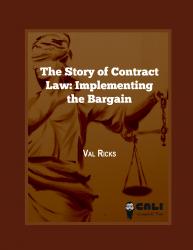 The Story of Contract Law: Implementing the Bargain
by
This book is a companion volume to Volume I, "The Story of Contract Law: Formation." Volume I introduces students to law study and teaches basic doctrines of contract formation along with formation defenses. This book, Volume II, The Story of Contract Law: Implementing the Bargain, covers the rest of basic contract doctrine, namely, laws that
1) determine the content of the bargain (plain meaning, usage and custom, good faith, mistake in transmission, parol evidence, and express and constructive conditions);
2) govern the effect of events that occur after formation (impracticability, frustration, failure of consideration, and risk of loss);
3) set remedies—rescission, damages, specific performance—available to courts when liability exists; and
4) establish the rights of third parties in contracts by assignment or delegation or as third-party beneficiaries.
This book includes many classic teaching cases and introduces new ones. The book also includes many problems, most based on actual cases. The book takes especial care with the doctrine of concurrent conditions, a common-law rule adopted in the late 1700s that required doctrinal readjustment across all the law governing contract performance and remedies.
This volume also continues several themes from Volume I. Volume II continues to tie rules to contract law’s central structural idea, that of fair exchange. Also, to the extent helpful to student understanding, Volume II explains doctrines in part through their chronological development. The book introduces the doctrines in the order best conducive to students’ understanding contract law as a regulatory whole; for this volume, it is the order in which the doctrines arise in litigation. Finally, where possible, this volume repeats ideas at helpful points and suggests ties between doctrines so that the structural coherence of contract doctrine becomes easier to understand.
The Story of Contract Law: Implementing the Bargain
by
This book is a companion volume to Volume I, "The Story of Contract Law: Formation." Volume I introduces students to law study and teaches basic doctrines of contract formation along with formation defenses. This book, Volume II, The Story of Contract Law: Implementing the Bargain, covers the rest of basic contract doctrine, namely, laws that
1) determine the content of the bargain (plain meaning, usage and custom, good faith, mistake in transmission, parol evidence, and express and constructive conditions);
2) govern the effect of events that occur after formation (impracticability, frustration, failure of consideration, and risk of loss);
3) set remedies—rescission, damages, specific performance—available to courts when liability exists; and
4) establish the rights of third parties in contracts by assignment or delegation or as third-party beneficiaries.
This book includes many classic teaching cases and introduces new ones. The book also includes many problems, most based on actual cases. The book takes especial care with the doctrine of concurrent conditions, a common-law rule adopted in the late 1700s that required doctrinal readjustment across all the law governing contract performance and remedies.
This volume also continues several themes from Volume I. Volume II continues to tie rules to contract law’s central structural idea, that of fair exchange. Also, to the extent helpful to student understanding, Volume II explains doctrines in part through their chronological development. The book introduces the doctrines in the order best conducive to students’ understanding contract law as a regulatory whole; for this volume, it is the order in which the doctrines arise in litigation. Finally, where possible, this volume repeats ideas at helpful points and suggests ties between doctrines so that the structural coherence of contract doctrine becomes easier to understand.
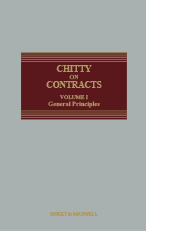 Chitty on Contracts (New Edition)
by
In this 35th edition of Chitty on Contracts, the editors have not only brought the account of the law up to date but have expanded its coverage and have sought to make it more accessible.
New developments:
The Chapter on Consideration has been split into two: Chapter 6 now deals with the doctrine of consideration itself and the new Chapter 7 (Estoppel) contains a separate and fuller account of the various kinds of estoppel, some of which can provide a substitute for consideration.
Chapter 18 (Exemption Clauses) contains a new and detailed explanation of the case law on “reasonableness” under the Unfair Contract Terms Act 1977.
Chapter 19 (Illegality and Public Policy) has been reorganised and expanded in the light of cases on the effects of illegality following the decision of the Supreme Court in Patel v Mirza.
Chapter 24 (Death and Bankruptcy) contains an expanded section on the effects of personal insolvency on contracts and a new section on the effects of corporate Insolvency.
Chapter 46 (Restrictive Agreements and Competition) has been revised and reorganised in the light of Brexit, to focus on the competition law of the United Kingdom, though with copious references to the case law of the Court of Justice of the European Union where that remains relevant in interpreting and applying UK competition law.
All developments in relevant legislation and case law that were available up to 31st July 2023 have been included, and some later cases. In particular:
Legislation
Retained EU Law (Revocation and Reform) Act 2023
Building Safety Act 2022
Electronic Trade Documents Act 2024
Financial Services and Markets Act 2023
Digital Markets, Competition and Consumers Bill 2023
Conduct of Employment Agencies and Employment Businesses (Amendment) Regulations 2022 (replacement of workers on strike).
Cases
The new edition contains too many new cases to list them all here, but the following are worth mentioning:
Umbrella Interchange Fee Claimants v Umbrella Interchange Fee Defendants, Walter Hugh Merricks CBE v Mastercard Inc (Volvo Limitation) (“retained” EU law, limitation period for events before IP completion day, application of CJEU judgment after IP completion day)
Barton v Morris (SC) (incomplete agreement);
Guest v Guest (SC)
SK Shipping Europe Plc v Capital VLCC 3 Corp (CA) (Misrepresentation Act 1967 s2(2))
Law Debenture Trust Corporation plc v Ukraine (SC) (Duress);
SR Projects Ltd v Rampersad (PC) (effect of exceeding borrowing limits)
Benyatov v Credit Suisse Securities (Europe) Ltd (CA) (agent’s right to indemnity)
The Claimants in the Royal Mail Group Litigation v Royal Mail Group Limited (CA)
Philipp v Barclays Bank UK Plc (SC)
Oxford University Innovation Ltd v Oxford Nanoimaging Ltd, Payward, Inc v Chechetkin and Eternity Sky Investments Ltd v Zhang (“consumer”; unfair contract terms)
Chitty on Contracts (New Edition)
by
In this 35th edition of Chitty on Contracts, the editors have not only brought the account of the law up to date but have expanded its coverage and have sought to make it more accessible.
New developments:
The Chapter on Consideration has been split into two: Chapter 6 now deals with the doctrine of consideration itself and the new Chapter 7 (Estoppel) contains a separate and fuller account of the various kinds of estoppel, some of which can provide a substitute for consideration.
Chapter 18 (Exemption Clauses) contains a new and detailed explanation of the case law on “reasonableness” under the Unfair Contract Terms Act 1977.
Chapter 19 (Illegality and Public Policy) has been reorganised and expanded in the light of cases on the effects of illegality following the decision of the Supreme Court in Patel v Mirza.
Chapter 24 (Death and Bankruptcy) contains an expanded section on the effects of personal insolvency on contracts and a new section on the effects of corporate Insolvency.
Chapter 46 (Restrictive Agreements and Competition) has been revised and reorganised in the light of Brexit, to focus on the competition law of the United Kingdom, though with copious references to the case law of the Court of Justice of the European Union where that remains relevant in interpreting and applying UK competition law.
All developments in relevant legislation and case law that were available up to 31st July 2023 have been included, and some later cases. In particular:
Legislation
Retained EU Law (Revocation and Reform) Act 2023
Building Safety Act 2022
Electronic Trade Documents Act 2024
Financial Services and Markets Act 2023
Digital Markets, Competition and Consumers Bill 2023
Conduct of Employment Agencies and Employment Businesses (Amendment) Regulations 2022 (replacement of workers on strike).
Cases
The new edition contains too many new cases to list them all here, but the following are worth mentioning:
Umbrella Interchange Fee Claimants v Umbrella Interchange Fee Defendants, Walter Hugh Merricks CBE v Mastercard Inc (Volvo Limitation) (“retained” EU law, limitation period for events before IP completion day, application of CJEU judgment after IP completion day)
Barton v Morris (SC) (incomplete agreement);
Guest v Guest (SC)
SK Shipping Europe Plc v Capital VLCC 3 Corp (CA) (Misrepresentation Act 1967 s2(2))
Law Debenture Trust Corporation plc v Ukraine (SC) (Duress);
SR Projects Ltd v Rampersad (PC) (effect of exceeding borrowing limits)
Benyatov v Credit Suisse Securities (Europe) Ltd (CA) (agent’s right to indemnity)
The Claimants in the Royal Mail Group Litigation v Royal Mail Group Limited (CA)
Philipp v Barclays Bank UK Plc (SC)
Oxford University Innovation Ltd v Oxford Nanoimaging Ltd, Payward, Inc v Chechetkin and Eternity Sky Investments Ltd v Zhang (“consumer”; unfair contract terms)
 Exclusion Clauses and Unfair Contract Terms
by
Exclusion Clauses and Unfair Contract Terms examines, in a detailed, practical, and incisive manner, this important area of contract law. It provides guidance to the practitioner on drafting and using exclusion clauses effectively within the formative phase of a contract. Additionally, it offers commentary on the possibility of challenging an exclusion clause. The text deals with exclusion clauses and unfair contract terms in the context of both commercial and consumer contracts, considering the legal tests which are applied to determine whether the exclusion clause has been successfully incorporated, how it should be interpreted, and the extent to which it might be invalidated at Common Law and under statute.
Key features:
Considers the ways in which exclusion clauses are controlled by the judiciary and regulated by legislation
Examines unlawful, void and ineffective exclusion clauses
Explains in a straightforward and practical manner how to draft exclusion clauses that are lawful, valid and effective
Deals with exclusion clauses and unfair contract terms in the context of both commercial and consumer contracts
Provides wholesale review of the recent case law
Analyses the courts’ interpretation of the meaning of “written standard terms” under the Unfair Contract terms Act.
Discusses how the courts are adjusting the process of construing exclusion clauses so as to harmonise this topic with the general principles of interpreting written contracts.
Considers in detail the impact of the Consumer Rights Act 2015.
Exclusion Clauses and Unfair Contract Terms
by
Exclusion Clauses and Unfair Contract Terms examines, in a detailed, practical, and incisive manner, this important area of contract law. It provides guidance to the practitioner on drafting and using exclusion clauses effectively within the formative phase of a contract. Additionally, it offers commentary on the possibility of challenging an exclusion clause. The text deals with exclusion clauses and unfair contract terms in the context of both commercial and consumer contracts, considering the legal tests which are applied to determine whether the exclusion clause has been successfully incorporated, how it should be interpreted, and the extent to which it might be invalidated at Common Law and under statute.
Key features:
Considers the ways in which exclusion clauses are controlled by the judiciary and regulated by legislation
Examines unlawful, void and ineffective exclusion clauses
Explains in a straightforward and practical manner how to draft exclusion clauses that are lawful, valid and effective
Deals with exclusion clauses and unfair contract terms in the context of both commercial and consumer contracts
Provides wholesale review of the recent case law
Analyses the courts’ interpretation of the meaning of “written standard terms” under the Unfair Contract terms Act.
Discusses how the courts are adjusting the process of construing exclusion clauses so as to harmonise this topic with the general principles of interpreting written contracts.
Considers in detail the impact of the Consumer Rights Act 2015.
 The Law of Contract
by
Treitel on the Law of Contract is recognised as the most thorough and discerning treatment of contract law. It is a widely adopted textbook for students and a valuable source of reference for practitioners. This new edition provides a clear and detailed analysis of an increasingly complex area of law.
Examines, and offers resolutions to, controversial and problematic points of law
Takes account of recent cases from the Supreme Court
Also covers important developments in the Court of Appeal
The Law of Contract
by
Treitel on the Law of Contract is recognised as the most thorough and discerning treatment of contract law. It is a widely adopted textbook for students and a valuable source of reference for practitioners. This new edition provides a clear and detailed analysis of an increasingly complex area of law.
Examines, and offers resolutions to, controversial and problematic points of law
Takes account of recent cases from the Supreme Court
Also covers important developments in the Court of Appeal
 European Contract Law
by
This 3rd edition provides information on core EU legislation as well as academic projects in order to unlock the content, approaches and objectives of European contract law. European contract law is not only a core aspect of European private law but also plays a highly important role in the development of contract law at national level. However, European contract laws contribution and significance are often overlooked and its content, approaches and objectives not fully understood. This revised and updated 3rd edition unlocks European contract law by providing fundamental information about core EU legislation, court decisions, and academic projects in order to show how a system arises from the interaction between the different sources. Moreover, this 3rd edition takes into account the recent legislative responses to digitalization and the development of a contract law for the 21st century.
European Contract Law
by
This 3rd edition provides information on core EU legislation as well as academic projects in order to unlock the content, approaches and objectives of European contract law. European contract law is not only a core aspect of European private law but also plays a highly important role in the development of contract law at national level. However, European contract laws contribution and significance are often overlooked and its content, approaches and objectives not fully understood. This revised and updated 3rd edition unlocks European contract law by providing fundamental information about core EU legislation, court decisions, and academic projects in order to show how a system arises from the interaction between the different sources. Moreover, this 3rd edition takes into account the recent legislative responses to digitalization and the development of a contract law for the 21st century.
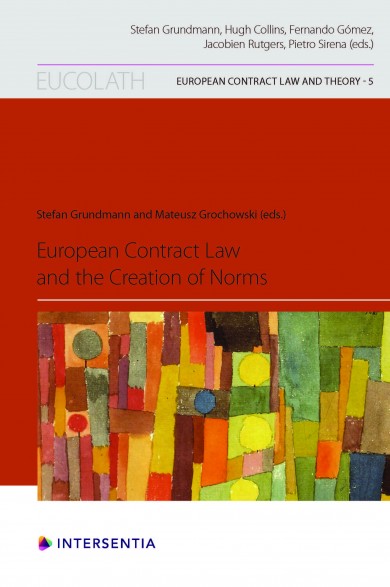 European Contract Law and the Creation of Norms
by
The book provides a broad and topical perspective of the sources of modern contract law. It examines the creation of contract law as a multi-pronged occurrence that involves diverse types of normative content and various actors. The book encompasses both a classical perspective on contract law as a state-created edifice and also delves into the setting of contractual rules by non-state actors. In so doing, the volume thoroughly analyses present-day developments to make sense of shifting attitudes towards the overall regulatory paradigm of contract law and those that reshape the classic view of the sources of contract law. The latter concerns, in particular, the digitalisation of markets and growing trends towards granularisation and personalisation of rules. The book builds on the EU private law perspective as its primary point of reference. At the same time, its reach goes far beyond this domain to include in-depth analysis from the vantage points of general contract theory and comparative analysis. In so doing, it pays particular attention to theoretical foundations of sources of contract law and values that underpin them. By adopting such diversified perspectives, the book attempts to provide for a better understanding of the nature and functions of present-day contract law by capturing the multitude of social and economic dynamics that shape its normative landscape. The volume gathers a unique and distinguished group of contributors from the EU, USA and Israel. They bring research experience from various areas of private law and contribute with diverse conceptual perspectives. Stefan Grundmann is Professor of Transnational Law and Theory at the European University Institute, Florence, Italy, and Professor of Private and Business Law at Humboldt-University, Berlin, Germany. Mateusz Grochowski is a Senior Research Fellow at the Max Planck Institute for Comparative and International Private Law, Hamburg, Germany, Assistant Professor at the Institute of Law Studies of the Polish Academy of Sciences, Warsaw, and Fellow at the Information Society Project, Yale Law School, United States.
European Contract Law and the Creation of Norms
by
The book provides a broad and topical perspective of the sources of modern contract law. It examines the creation of contract law as a multi-pronged occurrence that involves diverse types of normative content and various actors. The book encompasses both a classical perspective on contract law as a state-created edifice and also delves into the setting of contractual rules by non-state actors. In so doing, the volume thoroughly analyses present-day developments to make sense of shifting attitudes towards the overall regulatory paradigm of contract law and those that reshape the classic view of the sources of contract law. The latter concerns, in particular, the digitalisation of markets and growing trends towards granularisation and personalisation of rules. The book builds on the EU private law perspective as its primary point of reference. At the same time, its reach goes far beyond this domain to include in-depth analysis from the vantage points of general contract theory and comparative analysis. In so doing, it pays particular attention to theoretical foundations of sources of contract law and values that underpin them. By adopting such diversified perspectives, the book attempts to provide for a better understanding of the nature and functions of present-day contract law by capturing the multitude of social and economic dynamics that shape its normative landscape. The volume gathers a unique and distinguished group of contributors from the EU, USA and Israel. They bring research experience from various areas of private law and contribute with diverse conceptual perspectives. Stefan Grundmann is Professor of Transnational Law and Theory at the European University Institute, Florence, Italy, and Professor of Private and Business Law at Humboldt-University, Berlin, Germany. Mateusz Grochowski is a Senior Research Fellow at the Max Planck Institute for Comparative and International Private Law, Hamburg, Germany, Assistant Professor at the Institute of Law Studies of the Polish Academy of Sciences, Warsaw, and Fellow at the Information Society Project, Yale Law School, United States.
 Todd on torts
by
The many and varied developments in the field of torts during the last 4 years mean that this new, 9th edition of Todd on Torts (formerly The Law of Torts in New Zealand) already is needed. As with previous editions, it seeks to explain and to discuss the evolving law in New Zealand and also to cover significant developments in the wider common law world. Major new or rewritten topics include:
The impact of tikanga Māori on the developing common law of torts
Using proceedings in tort as a means of controlling global warming
The scope of the duty of care and the relationship between the duty issue and the cause of harm
Liability issues arisng out of a biosecurity failure at New Zealand’s borders
The direct liability of parent companies for the torts of their subsidiaries
Visual intrusion into property as constituting a nuisance.
The ambit of the elements to vicarious liability
Todd on Torts is the definitive tort work for law students and practitioners. Its exemplary standards and authoritative reputation are both demonstrated by the fact that it is the book most frequently cited in decisions of the New Zealand Courts.
Todd on torts
by
The many and varied developments in the field of torts during the last 4 years mean that this new, 9th edition of Todd on Torts (formerly The Law of Torts in New Zealand) already is needed. As with previous editions, it seeks to explain and to discuss the evolving law in New Zealand and also to cover significant developments in the wider common law world. Major new or rewritten topics include:
The impact of tikanga Māori on the developing common law of torts
Using proceedings in tort as a means of controlling global warming
The scope of the duty of care and the relationship between the duty issue and the cause of harm
Liability issues arisng out of a biosecurity failure at New Zealand’s borders
The direct liability of parent companies for the torts of their subsidiaries
Visual intrusion into property as constituting a nuisance.
The ambit of the elements to vicarious liability
Todd on Torts is the definitive tort work for law students and practitioners. Its exemplary standards and authoritative reputation are both demonstrated by the fact that it is the book most frequently cited in decisions of the New Zealand Courts.
 The Cambridge Handbook of Smart Contracts, Blockchain Technology and Digital Platforms
by
The product of a unique collaboration between academic scholars, legal practitioners, and technology experts, this Handbook is the first of its kind to analyze the ongoing evolution of smart contracts, based upon blockchain technology, from the perspective of existing legal frameworks - namely, contract law. The book's coverage ranges across many areas of smart contracts and electronic or digital platforms to illuminate the impact of new, and often disruptive, technologies on the law. With a mix of scholarly commentary and practical application, chapter authors provide expert insights on the core issues involving the use of smart contracts, concluding that smart contracts cannot supplant contract law and the courts, but leaving open the question of whether there is a need for specialized regulations to prevent abuse. This book should be read by anyone interested in the disruptive effect of new technologies on the law generally, and contract law in particular.
The Cambridge Handbook of Smart Contracts, Blockchain Technology and Digital Platforms
by
The product of a unique collaboration between academic scholars, legal practitioners, and technology experts, this Handbook is the first of its kind to analyze the ongoing evolution of smart contracts, based upon blockchain technology, from the perspective of existing legal frameworks - namely, contract law. The book's coverage ranges across many areas of smart contracts and electronic or digital platforms to illuminate the impact of new, and often disruptive, technologies on the law. With a mix of scholarly commentary and practical application, chapter authors provide expert insights on the core issues involving the use of smart contracts, concluding that smart contracts cannot supplant contract law and the courts, but leaving open the question of whether there is a need for specialized regulations to prevent abuse. This book should be read by anyone interested in the disruptive effect of new technologies on the law generally, and contract law in particular.
17A Am. Jur. 2d Contracts, Westlaw (database updated Nov. 2022).
17 C.J.S. Contracts, Westlaw (database updated Nov. 2022).
לפניות והערות כתבו ל:irinabo@savion.huji.ac.il
מעודכן ל: 8.9.2025
כל האזכורים של מקורות יש לאזכר לפי כללי האזכור האחיד והבלובוק. סרטוני הדרכה על אזכור חקיקה ופסיקה.
|